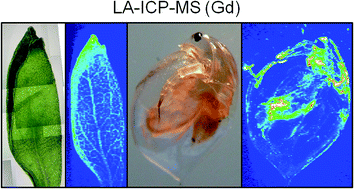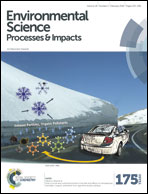Gadolinium-uptake by aquatic and terrestrial organisms-distribution determined by laser ablation inductively coupled plasma mass spectrometry†
Abstract
Gadolinium (Gd) based contrast agents (CA) are used to enhance magnetic resonance imaging. As a consequence of excretion by patients and insufficient elimination in wastewater treatment plants they are detected in high concentrations in surface water. At present, little is known about the uptake of these species by living organisms in aquatic systems. Therefore the uptake of gadolinium containing chelates by plants and animals grown in exposed water or on soil irrigated with exposed water was investigated. For this purpose two types of plants were treated with two different contrast agents. The uptake of the Gd contrast agents was studied by monitoring the elemental distribution with laser ablation inductively coupled plasma mass spectrometry (LA-ICP-MS). This technique allows the multi-elemental analysis of solid samples with high resolution and little sample preparation. The analysis of L. minor showed that the uptake of Gd correlated with the concentration of gadodiamide in the water. The higher the concentration in the exposed water, the larger the Gd signal in the LA-ICP-MS acquired image. Exposure time experiments showed saturation within one day. The L. minor had contact with the CAs through roots and fronds, whereas the L. sativum only showed uptake through the roots. These results show that an external absorption of the CA through the leaves of L. sativum was impossible. All the analyzed parts of the plant showed Gd signal from the CA; the highest being at the main vein of the leaf. It is shown that the CAs can be taken up from plants. Furthermore, the uptake and distribution of Gd in Daphnia magna were shown. The exposure via cultivation medium is followed by Gd signals on the skin and in the area of the intestine, while the uptake via exposed nutrition algae causes the significantly highest Gd intensities in the area of the intestine. Because there are hints of negative effects for human organism these findings are important as they show that Gd based CAs may reach the human food chain via plants and animals growing in contaminated water or plants growing in fields which are irrigated with surface water.


 Please wait while we load your content...
Please wait while we load your content...